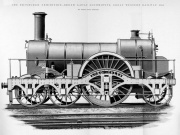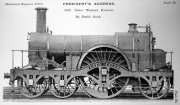Difference between revisions of "Daniel Gooch"
| (13 intermediate revisions by 4 users not shown) | |||
| Line 1: | Line 1: | ||
[[image:Im1868Egv5-p154a.jpg |thumb|1872.]] | |||
[[image:Im1960v209-p554c.jpg |thumb| 1960. ]] | |||
[[image:Im1894OurRail1-Gooch.jpg|thumb| ]] | [[image:Im1894OurRail1-Gooch.jpg|thumb| ]] | ||
[[Image:Im19390506PP-Gooch.jpg|thumb| ]] | [[Image:Im19390506PP-Gooch.jpg|thumb| ]] | ||
[[Image:Im1890IME-pl056.jpg|thumb| 1846. The [[Locomotive: Lord of the Isles|Lord of the Isles]] engine for the [[Great Western Railway]]. ]] | [[Image:Im1890IME-pl056.jpg|thumb| 1846. The [[Locomotive: Lord of the Isles|Lord of the Isles]] engine for the [[Great Western Railway]]. ]] | ||
[[image:Im1925EnV139-p258b.jpg |thumb| 1847. Great Western Engine "Iron Duke". ]] | |||
[[Image:Im1890IME-pl057.jpg|thumb| 1847. The 'Corsair' engine for the [[Great Western Railway]]. ]] | [[Image:Im1890IME-pl057.jpg|thumb| 1847. The 'Corsair' engine for the [[Great Western Railway]]. ]] | ||
[[image:Im1925EnV139-p258c.jpg |thumb| 1849. Saddle Tank Engine.]] | |||
[[Image:Im1890EnV69-p490a.jpg|thumb| 1851. The [[Locomotive: Lord of the Isles|Lord of the Isles]] as shown at The Edinburgh Exhibition.]] | [[Image:Im1890EnV69-p490a.jpg|thumb| 1851. The [[Locomotive: Lord of the Isles|Lord of the Isles]] as shown at The Edinburgh Exhibition.]] | ||
[[image:Im1960v209-p556a.jpg |thumb|]] | [[image:Im1960v209-p556a.jpg |thumb|]] | ||
[[image:Im1960v209-p555a.jpg |thumb| 1960. Broad Gauge Locomotive "Firefly". ]] | [[image:Im1960v209-p555a.jpg |thumb| 1960. Broad Gauge Locomotive "Firefly". ]] | ||
Daniel Gooch (1816-1889) Locomotive Engineer and Manager. | Daniel Gooch (1816-1889) Locomotive Engineer and Manager. | ||
| Line 17: | Line 20: | ||
Gooch went on to work in the Tredegar Ironworks foundry, in South Wales. | Gooch went on to work in the Tredegar Ironworks foundry, in South Wales. | ||
1837 Aged twenty-one, Gooch was appointed locomotive superintendent of the [[Great Western Railway]] and soon took advantage of the broad gauge favoured by [[Isambard Kingdom Brunel]] who was | 1837 Aged twenty-one, Gooch was appointed locomotive superintendent of the [[Great Western Railway]] and soon took advantage of the broad gauge favoured by [[Isambard Kingdom Brunel]] who was the company's chief engineer, as his locomotives were much faster than those previously made. Gooch's locomotives could haul a large load at 60 mph (96 kph). Gooch designed 340 locomotives in all and these included the ''Great Western'' and the ''Iron Duke''. | ||
1849 The 4-4-0 saddle tank engines built in 1849, were amongst the most interesting of Gooch's designs. The type of bogie, which with minor modifications was in use until May, 1892, swivelled on a ball and socket joint, the socket being connected diagonally with the horn plates by four strong forgings, 5in. deep by 11 1/8in thick.<ref>The Engineer 1925/03/06</ref> | |||
1864 Daniel Gooch worked for the Great Western Railway for twenty-seven years, but resigned in 1864 to concentrate on developing telegraphic communication. Gooch became chairman of the [[Telegraph Construction and Maintenance Co]] (Telcon) and director of the [[Anglo-American Telegraph Co]]. | 1864 Daniel Gooch worked for the Great Western Railway for twenty-seven years, but resigned in 1864 to concentrate on developing telegraphic communication. Gooch became chairman of the [[Telegraph Construction and Maintenance Co]] (Telcon) and director of the [[Anglo-American Telegraph Co]]. | ||
1865 In the General Election Daniel Gooch became MP for Cricklade. Later that year, when the [[Great Western Railway]] got into financial difficulties, he agreed to resume chairmanship and the company's profits soon returned. As chairman of the company | 1865 In the General Election Daniel Gooch became MP for Cricklade. Later that year, when the [[Great Western Railway]] got into financial difficulties, he agreed to resume chairmanship and the company's profits soon returned. As chairman of the company he fully supported Brunel's proposal to build the steamship, the ''Great Western''. | ||
1871 Living at Warwick Villas, Paddington (age 54 born Bedlington), Baronet and M.P.. With his wife Emily (age 29 born Norwood, Surrey) and their son Alfred W. (age 25 born Paddington), Civil Engineer. Also seven servants. <ref>1871 Census</ref> | 1871 Living at Warwick Villas, Paddington (age 54 born Bedlington), Baronet and M.P.. With his wife Emily (age 29 born Norwood, Surrey) and their son [[Alfred William Gooch|Alfred W.]] (age 25 born Paddington), Civil Engineer. Also seven servants. <ref>1871 Census</ref> | ||
1881 Staying at the Imperial Hotel, Malvern (age 64 born Bedlington), Baronet and M.P.. With his wife Emily (age 38 born Norwood, Surrey). <ref>1881 Census</ref> | 1881 Staying at the Imperial Hotel, Malvern (age 64 born Bedlington), Baronet and M.P.. With his wife Emily (age 38 born Norwood, Surrey). <ref>1881 Census</ref> | ||
| Line 33: | Line 38: | ||
1889 October 15th. Daniel Gooch died at Clewer Park, Berkshire, and was buried in St. Andrews Church, Clewer, near Windsor. | 1889 October 15th. Daniel Gooch died at Clewer Park, Berkshire, and was buried in St. Andrews Church, Clewer, near Windsor. | ||
'''Diaries | |||
Fortunately, Gooch kept voluminous diaries, and collected extracts were first published in 1892, and reissued in 2006 <ref>'The Diaries of Sir Daniel Gooch. Introduction by Sir Theodore Martin'. First published 1892, reissued in paperback in 2006 by Nonsuch Publishing</ref>. Approximately half of the book is devoted to a fascinating account of his work in connection with the first successful transatlantic telegraph cables. | |||
''' Summary of Best-known works | |||
* Locomotive Assistant to [[Isambard Kingdom Brunel]] at [[Great Western Railway|GWR]] from 1837-64 | * Locomotive Assistant to [[Isambard Kingdom Brunel]] at [[Great Western Railway|GWR]] from 1837-64 | ||
* Laid out the original [[Swindon Works]] | * Laid out the original [[Swindon Works]] | ||
* Designed locomotives [[ | * Designed many locomotives, including [[Jones, Turner and Evans: Fire Fly|Firefly 1840]], [[Locomotive: Great Western 1846| Great Western 1846]] and a heavy 4-4-0ST design for use west of Exeter. | ||
* Left GWR in 1864 to supervise laying of Atlantic cable but returned the | * Left the GWR in 1864 to become Chairman of the [[Telegraph Construction and Maintenance Co]]. He sailed on the [[SS Great Eastern]] to supervise the laying of the Atlantic cable in 1865. This broke after 1000 miles, but he returned to oversee the laying of the successful cable in 1866. He made another voyage in 1869 for the laying of the cable from Brest to Canada | ||
* During the cable period he was elected as an MP, and also became Chairman of the GWR in 1865. | |||
== See Also == | == See Also == | ||
| Line 50: | Line 60: | ||
{{DEFAULTSORT: Gooch, Daniel}} | {{DEFAULTSORT: Gooch, Daniel}} | ||
[[Category: Biography]] | [[Category: Biography]] | ||
[[Category: Biography - Railways]] | |||
[[Category: Steam Pioneer]] | [[Category: Steam Pioneer]] | ||
[[Category: Births 1810-1819]] | [[Category: Births 1810-1819]] | ||
[[Category: Deaths 1860-1869]] | [[Category: Deaths 1860-1869]] | ||
Latest revision as of 16:32, 16 March 2015


Daniel Gooch (1816-1889) Locomotive Engineer and Manager.
1816 August 24th. Born in Bedlington the son of John Gooch of Bedlington and his wife Anna the daughter of Thomas Longridge of Newcastle.
As a young boy Gooch met George Stephenson and, as soon as he was old enough, he became an engineer at the the locomotive factory owned by Edward Pease and Robert Stephenson, in Newcastle-upon-Tyne.
Gooch went on to work in the Tredegar Ironworks foundry, in South Wales.
1837 Aged twenty-one, Gooch was appointed locomotive superintendent of the Great Western Railway and soon took advantage of the broad gauge favoured by Isambard Kingdom Brunel who was the company's chief engineer, as his locomotives were much faster than those previously made. Gooch's locomotives could haul a large load at 60 mph (96 kph). Gooch designed 340 locomotives in all and these included the Great Western and the Iron Duke.
1849 The 4-4-0 saddle tank engines built in 1849, were amongst the most interesting of Gooch's designs. The type of bogie, which with minor modifications was in use until May, 1892, swivelled on a ball and socket joint, the socket being connected diagonally with the horn plates by four strong forgings, 5in. deep by 11 1/8in thick.[1]
1864 Daniel Gooch worked for the Great Western Railway for twenty-seven years, but resigned in 1864 to concentrate on developing telegraphic communication. Gooch became chairman of the Telegraph Construction and Maintenance Co (Telcon) and director of the Anglo-American Telegraph Co.
1865 In the General Election Daniel Gooch became MP for Cricklade. Later that year, when the Great Western Railway got into financial difficulties, he agreed to resume chairmanship and the company's profits soon returned. As chairman of the company he fully supported Brunel's proposal to build the steamship, the Great Western.
1871 Living at Warwick Villas, Paddington (age 54 born Bedlington), Baronet and M.P.. With his wife Emily (age 29 born Norwood, Surrey) and their son Alfred W. (age 25 born Paddington), Civil Engineer. Also seven servants. [2]
1881 Staying at the Imperial Hotel, Malvern (age 64 born Bedlington), Baronet and M.P.. With his wife Emily (age 38 born Norwood, Surrey). [3]
1885 On leaving Parliament, Gooch continued as chairman of the Great Western Railway.
1886 Gooch pioneered the Severn Tunnel project.
1889 October 15th. Daniel Gooch died at Clewer Park, Berkshire, and was buried in St. Andrews Church, Clewer, near Windsor.
Diaries
Fortunately, Gooch kept voluminous diaries, and collected extracts were first published in 1892, and reissued in 2006 [4]. Approximately half of the book is devoted to a fascinating account of his work in connection with the first successful transatlantic telegraph cables.
Summary of Best-known works
- Locomotive Assistant to Isambard Kingdom Brunel at GWR from 1837-64
- Laid out the original Swindon Works
- Designed many locomotives, including Firefly 1840, Great Western 1846 and a heavy 4-4-0ST design for use west of Exeter.
- Left the GWR in 1864 to become Chairman of the Telegraph Construction and Maintenance Co. He sailed on the SS Great Eastern to supervise the laying of the Atlantic cable in 1865. This broke after 1000 miles, but he returned to oversee the laying of the successful cable in 1866. He made another voyage in 1869 for the laying of the cable from Brest to Canada
- During the cable period he was elected as an MP, and also became Chairman of the GWR in 1865.
See Also
Sources of Information
- Chris de Winter Hebron, 50 Famous Railwaymen, 2005
- [1] Spartacus Educational










